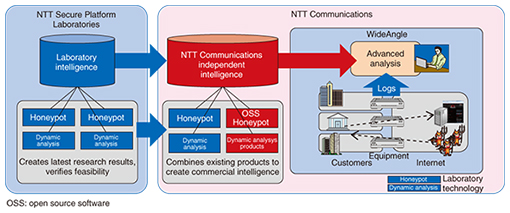 |
|||||||||||
|
|
|||||||||||
|
Feature Articles: Cybersecurity-related R&D to Counter Global Threats Vol. 13, No. 12, pp. 15–21, Dec. 2015. https://doi.org/10.53829/ntr201512fa3 Security Intelligence for Malware Countermeasures to Support NTT Group’s Security BusinessAbstractCyber-attacks caused by malware (malicious software) are becoming a serious social problem in many parts of the world. In this article, we introduce the security intelligence technology behind our WideAngle global integrated security service. Keywords: malware, security intelligence, WideAngle 1. IntroductionCyber-attacks have been causing a number of social problems in recent years. In particular, malware infections inflict severe damage and can cause leakage of information at a national level. An example of a malware attack on a personal computer (PC) is shown in Fig. 1. When a PC with vulnerabilities in its web browser or plugins visits a portal or relay site that has been created by an attacker to automatically forward content, it is automatically transferred to an attack site containing attack codes that cause the browser to become infected by downloading malware. A PC that has been infected with malware by accessing a series of malicious sites in this way will exchange information with a command site created by the attackers for purposes such as information theft.
At NTT’s laboratories, we have been researching and developing technology to detect infection activity, collect malware, and analyze the infection pathways and malware behavior [1]. By continuously collecting and analyzing attacks, we have created techniques for efficiently and accurately characterizing the latest malware infections. Recently, however, it has become difficult to create services that lead to effective countermeasures using a single technology alone due to the increasing complexity of attacks and the emergence of malware attacks with a very short cycle. From empirical knowledge obtained in previous research and development (R&D) and from observing attacks, we realized the importance of the security intelligence and its effect on malicious activity. The security intelligence includes the destinations of traffic related to malware infections, which are obtained through cross-sectional analysis of traffic data and attacks occurring up to and beyond the point of malware infection. Therefore, we began conducting R&D on world-leading intelligence creation techniques [2]. Furthermore, in partnership with NTT Communications, which is a world leader in the global security business, we expanded our security intelligence efforts into the WideAngle managed security service [3]. 2. NTT security intelligenceIn general, security intelligence refers to information used to defend against cyber-attacks. For example, this includes the originating Internet protocol (IP) addresses of DDoS (distributed denial of service) attacks or spam emails, or the IP addresses of botnet C&C (command & control) servers or collection sites for stolen data, and the Uniform Resource Locators (URLs) of phishing sites and fake websites. A wide variety of cyber-attacks originate from PCs and servers that have been compromised by attackers via malware infection. Therefore, to fundamentally solve the problem of cyber-attacks, it is absolutely essential to have security intelligence for deploying malware infection countermeasures. Also, to develop security intelligence into a business, it is important to have clear documented information on which to base malignancy decisions, as well as information on how it is used. At NTT’s laboratories, security intelligence includes information such as the destination IP addresses and URLs of traffic at the time of malware infection and the destination of traffic from the infected victim, as shown in Fig. 2.
Each item of information is associated with evidence identified using proprietary techniques such as decoy systems (honeypots) and dynamic malware analysis systems. These techniques are applied in parallel to identify the URLs of malware sites that cannot be collected by other companies. Furthermore, the URLs of these malware sites are analyzed to identify unknown malware site URLs. 2.1 HoneypotsMalware is collected by using decoy systems called honeypots to accept attacks. By analyzing the communication with honeypots, we can gather evidence about the vulnerabilities that are being used by attackers to spread their malware, and to identify information that is effective for preventing infection. We are conducting R&D on honeypots that keep up with the trends in malware infection activity. We are currently researching and developing web server honeypots to attract attacks that exploit vulnerabilities in web applications, and honeyclients to attract attacks that exploit vulnerabilities in web browsers and plugins. Here, we introduce a honeyclient that performs a key role in intelligence creation. In general, honeypots are classified into two categories: low-interaction honeypots that securely gather the minimum amount of information by simulating a vulnerable system, and high-interaction honeypots that collect a lot more information by using an actual vulnerable system. Although high-interaction honeypots are said to run the risk of being infected with malware, we have managed to develop a secure high-interaction honeyclient. Also, low-interaction honeypots are said to be only capable of collecting limited information, but we have managed to develop one with improved information-gathering capabilities. With a honeyclient, it is possible to detect malware infections and identify the URLs of malware sites that infect visitors with malware. Then malware infections can be prevented by prohibiting access to such URLs. 2.2 Dynamic analysis of malwareMalware collected by honeypots is analyzed to shed light on its latent threats by investigating its functions in detail. Furthermore, by analyzing the traffic generated by malware infections to discover information such as the servers they communicate with when obtaining additional malware and the command servers set up by the attackers, it is possible to identify information that is effective for suppressing the damaging effects of malware. Malware analysis includes dynamic analysis, which clarifies the behavior of malware by actually running it, and static analysis, which deciphers the malware’s program code. Dynamic analysis is introduced here. Dynamic analysis can be performed either in a closed environment, where the malware is operated in complete isolation, or in an open environment, where the malware can connect to the Internet. In both types of environment, a debugger can be used to closely monitor the malware’s behavior. Furthermore, taint analysis techniques can be used to track the flow of data handled within a system and identify servers prepared by the attackers to send data causing malicious behavior. For example, PCs that have been infected with malware can be discovered by identifying the PCs that access the command server or destination server when acquiring additional malware. 2.3 HoneytokensDuring the dynamic analysis of malware collected by a honeypot, it is possible to allow the attacker to tamper with a controlled decoy website by deploying false information for the website administrator’s account in the analysis environment. This makes it possible to collect the latest attack information. As mentioned previously, the greatest threat of malware infection in recent years has been caused by users unknowingly visiting malware sites. Parts of the malware deployed in these attacks have functions that collect and send out various kinds of account information. Therefore, when a website administrator’s account information is recorded on an infected PC, this information is leaked to the attacker so the website can be manipulated by the attacker, as shown in Fig. 3(a). A honeytoken shows nothing but decoy information. Since the content of a website is often managed via a File Transfer Protocol (FTP) server, fake FTP account information is prepared as a honeytoken. The attacker uses the honeytoken information to log in to a separate fake FTP server and tampers with its content. Checking the falsified content in the honeypot makes it possible to collect security intelligence about the latest attacks initiated by the attacker (Fig. 3(b)).
A paper summarizing this technique [4] was the first Japanese-authored paper in ten years to be accepted at one of the highest-level international conferences and was highly rated all over the world. 2.4 Searching the neighborhood of malware sitesTo avoid defenses set up based on security intelligence, attackers construct numerous malignant sites. Since they are reluctant or unable to spend much money on each site, they adopt configurations that enable new malware sites to be set up without incurring much additional cost. In anticipation of this trend, we identify malware sites by searching for web spaces that are highly likely to have been created by attackers. This search technique is shown in Fig. 4. We first extract URLs with the same path structures as existing malware site URLs in URL groups that exist in the same private domains as the URLs of known malware sites, and then we investigate these URLs using honeypots. An attacker who manages a known malignant site URL will be able to generate such URLs without incurring any cost burden, so with this search technique it is possible to discover malignant URLs prepared by attackers that are intended to avoid security intelligence. This technique was summarized in a paper that achieved global recognition [5] and received the best paper award at a major international conference.
3. Global business development of security intelligenceThe honeypot and analysis techniques and the security intelligence services created at NTT’s laboratories are being put to use in the services offered by NTT Communications. By implementing a combination of laboratory techniques, security intelligence, and existing products, NTT Communications is creating its own independent security intelligence, as shown in Fig. 5.
In business applications, we envisage that security intelligence could be deployed in services such as log auditing, user access filtering, or monitoring user websites. We have been using security intelligence in NTT Communications’ managed security services for log auditing since February 2013. In this service, security intelligence is used to detect security risks by employing advanced correlation analysis and to automatically assess threat levels. In this way, correlation analysis is done automatically on vast amounts of security information such as communication log files collected using ICT (information and communication technology) equipment, enabling an advanced and rapid response to any detected threats. Our managed security services are currently marketed under the WideAngle brand name, and they provide globally seamless comprehensive security countermeasures to users by conducting advanced security monitoring all day, every day based on a security provider system that includes over 900 specialists in 14 countries worldwide. 4. Future prospectsIn the future, we plan to work on making our global business more competitive and on developing our security business while prototyping NTT’s leading-edge security technology. References
|
|||||||||||















